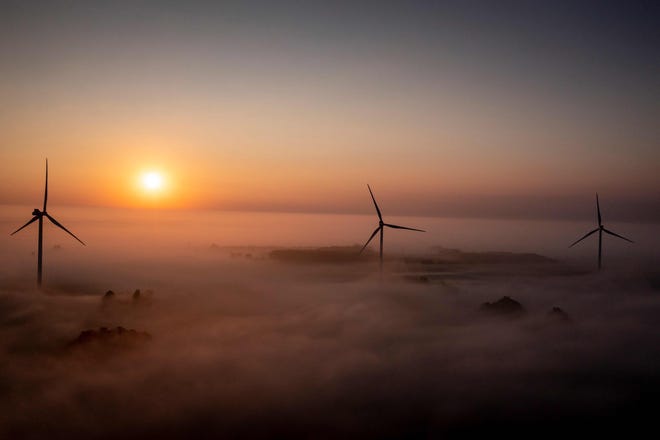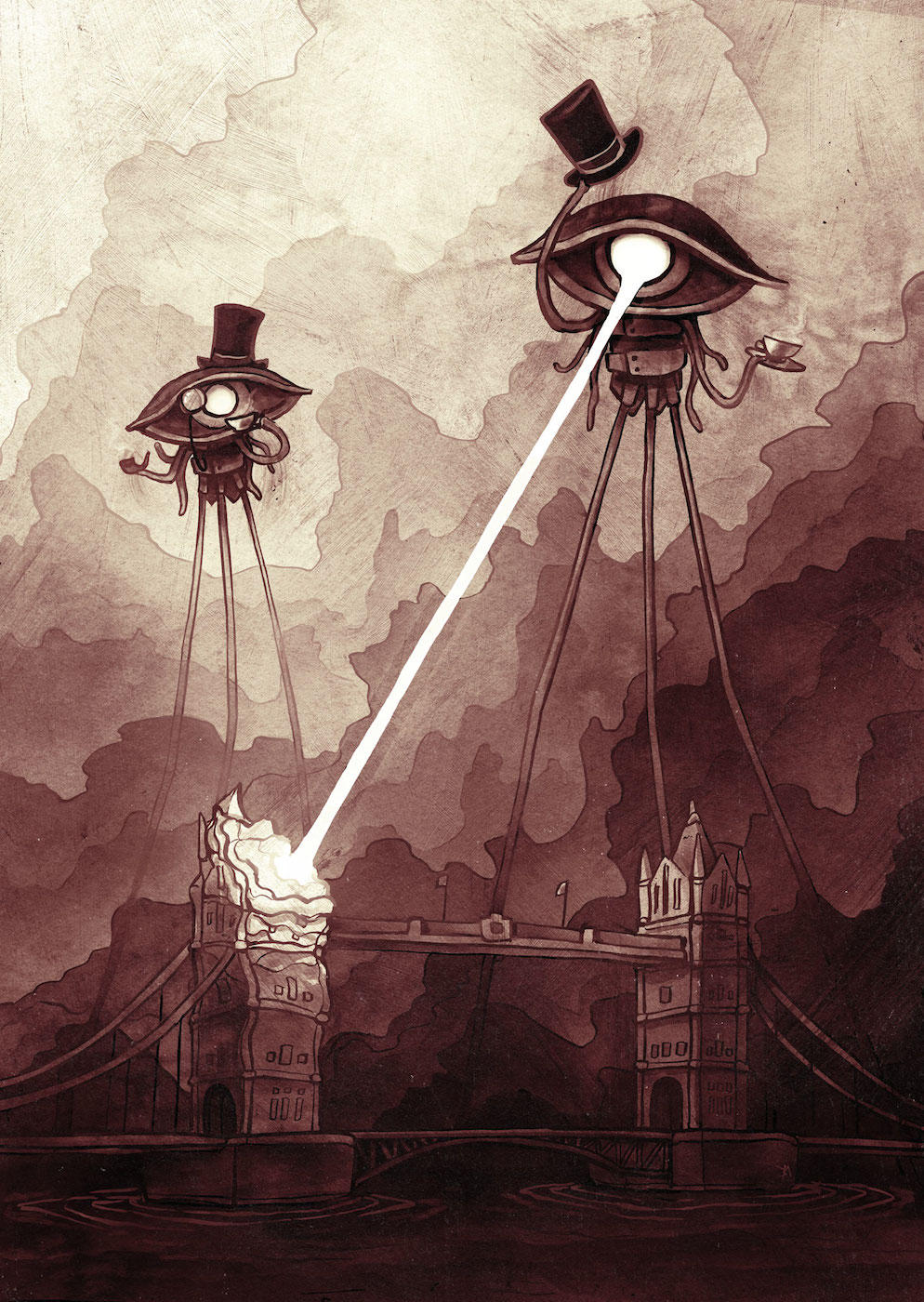Kate S. Petersen
USA TODAY
The claim: Wind power turbine blades cannot be recycled
As the U.S. continues to build up its wind power infrastructure, a claim is circulating on social media questioning just how green this alternative energy is.
Alongside an image of a bulldozer burying wind turbine blades, the post says: “These blades need to be disposed of and there is presently no way to recyle (sic) them. That’s how green energy works!”
A Facebook version of the meme from Nov. 5, was shared more than 200 times within 10 days.
But it's not exactly right.
It is true that decommissioned wind turbine blades are often thrown away in landfills.
The image in the meme shows blades being buried at the Casper Regional Landfill in Wyoming. It was taken by photographer Benjamin Rasmussen and featured in a February 2020 Bloomberg article about blade waste.
However, experts say there are ways to recycle them – though the technology has not been implemented on a large scale.
Special access for subscribers! Click here to sign up for our fact-check text chat
USA TODAY reached out to the social media users who shared the claim.
Twitter user @CharlesHawtrey3 acknowledged that blades could potentially be recycled. "Some companies say they are recycling blades, but ... the amount they recycle is minimal," the user told USA TODAY in a direct message.
Wind turbine blades can be recycled now, though the practice is not widespread
Wind turbine blades have typically been constructed to last for 20 to 25 years. This means many blades that are being decommissioned now were made a couple decades ago.
At that time, they weren't designed with recycling in mind, Kazem Fayazbakhsh, an assistant professor at Ryerson University, told USA TODAY. They have a chemical composition that makes it difficult to separate them into their constituent components at the end of their service life.
However, there are multiple contemporary examples of successful wind turbine blade recycling.
Fayazbakhsh has published papers documenting his team's success in creating a 3D printing feedstock from recycled windmill blades. He says they have also started a company, Fibrecycle Materials Corp., to commercialize this process.
Global Fiberglass Solutions is a U.S. start-up that is working to scale up its proprietary wind turbine blade recycling technology, CEO Don Lilly told USA TODAY. The company's website advertises diverse recycled products such as building materials and railroad ties.
"Windmill blades can be recycled," Karl Englund, CTO of Global Fiberglass Solutions and associate research professor at Washington State University, told USA TODAY. “We have proven that over and over again.”
Englund has published multiple papers documenting his wind turbine blade recycling successes.

Danish company Miljøskærm has successfully commercialized noise barriers made from recycled wind turbine blades, according to the company’s CEO, Jakob W Nielsen.
He said his company's products are currently available for purchase, and they are continuing to expand their business.
“We consider our acoustic insulation and noise barrier products as the first step in the development of a wider product range," he told USA TODAY in an email. "We are currently in the process of product developments with interesting commercial potential.”
The catch here is that while wind turbine blade recycling is technically possible, landfill disposal remains the most cost-efficient and accessible option in many cases.
“Physical and material scientists can recycle blades now," Eric Lantz, wind analysis manager at National Renewable Energy Laboratory told USA TODAY in an email. "But, broadly speaking, scaling up recycling technologies will require more research and development to maximize the value of the recycled materials and improve the economics of the processes.”
Fact check: Storm damaged a wind turbine in Texas, not a heat wave
Englund also pointed to a lack of investor buy-in as a potential obstacle, even after a technology becomes viable at scale.
Wind companies commit to turbine blade recycling
If decommissioned wind turbine blades continue to be thrown out, 2.2 million tons could end up in U.S. landfills by 2050, according to a study led by Aubryn Cooperman, a mechanical engineering researcher at National Renewable Energy Laboratory.
This amount “is non-trivial, but it is also one of many significant sources of potential waste across the economy,” Cooperman told USA TODAY in an email.
As an example, the EPA reports that nearly 27 million tons of plastic were dumped in U.S. landfills in 2018 alone. That amount is more than ten times the amount of windmill blade refuse that may accumulate by 2050.
Nevertheless, the industry is seeking ways to limit this waste.
European wind industry group WindEurope has called for a Europe-wide ban on the disposal of wind turbine blades in landfills by 2025.
GE Renewable Energy announced an agreement with German company, neowa, to recycle decommissioned blades. neowa recycles wind turbine blades into a product used to replace sand in cement manufacturing, CEO Frank Kroll told USA TODAY in an email.
Swedish utility Vattenfall has reportedly pledged to immediately stop dumping blades in landfills and to recycle all decommissioned blades by 2030. Danish energy company Ørsted also announced a plan to “reuse, recycle or recover all of the wind turbine blades in its global portfolio,” according to a June 2021 press release.
Fact check: Critique of windmills is a misquote, is misattributed to Thomas Homer-Dixon
While traditional turbine blades can currently be recycled through innovative techniques, wind power researchers and wind companies have started creating blades with ease of recycling in mind.
Researchers at National Renewable Energy Laboratory have created a more recyclable blade prototype using a “material technology (that) is actively being researched at a large scale and is likely to be adopted by industry,” Robynne Murray, a mechanical engineering researcher at the laboratory, told USA TODAY in an email.
In September, Spanish renewable energy company Siemens Gamesa, also announced the creation of a new, more easily recycled turbine blade.
Our rating: Missing context
Based on our research, we rate MISSING CONTEXT the claim that wind power turbine blades cannot be recycled, because without additional information it could be misleading. The blades can technically be recycled, and an array of small-scale efforts are doing so. But the practice is not widespread due to the cost of the undertaking and a lack of infrastructure.
Our fact-check sources:
Resources, Conservation, and Recycling, Feb. 1, Wind turbine blade material in the United States: Quantities, costs, and end-of-life options
Kazem Fayazbakhsh, Nov. 12, Interview with USA TODAY
Fast Company, Sept. 10, This giant wind turbine blade can be recycled
CNBC, Sept. 7, Wind turbine giant Siemens Gamesa claims world-first in blade recycling
Siemens Gamesa, Sept. 7, Siemens Gamesa pioneers wind circularity: launch of world’s first recyclable wind turbine blade for commercial use offshore
Miljøskærm, accessed Nov. 15, Products
Jakob Nielsen, Nov. 15, Email exchange with USA TODAY
Don Lilly, Nov. 15, Interview with USA TODAY
Global Fiberglass Solutions, accessed Nov. 18, Website
Reuters, Oct. 12, Sweden's Vattenfall to stop sending wind turbine blades to landfill
Ørsted, Feb. 6, Ørsted commits to sustainable recycling of wind turbine blades
Reuters, May 16, End of wind power waste? Vestas unveils blade recycling technology
Materials, Nov. 27, 2019, Recycled Glass Fiber Composites from Wind Turbine Waste for 3D Printing Feedstock: Effects of Fiber Content and Interface on Mechanical Performance
GE Renewable Energy, June 10, GE Renewable Energy announces onshore wind turbine decommissioning and recycling agreement with neowa
Bloomberg, Feb. 5, 2020, Wind Turbine Blades Can’t Be Recycled, So They’re Piling Up in Landfills
Karl Englund, Nov. 16, Interview with USA TODAY
Aubryn Cooperman, Nov. 11-16, Email exchange with USA TODAY
Robynne Murray, Nov. 11-16, Email exchange with USA TODAY
Eric Lantz, Nov. 16-18, Email exchange with USA TODAY
Waste Management, Mar. 2, 2018, Recycled wind turbine blades as a feedstock for second generation composites
Waste and Biomass Valorization, Apr. 4, 2019, Extruded Fiber-Reinforced Composites Manufactured from Recycled Wind Turbine Blade Material
Carbon Rivers, accessed Nov. 16, Website
WindEurope, June 16, Wind industry calls for Europe-wide ban on landfilling turbine blades
NREL, Nov. 1, NREL Explores Innovative Manufacturing Approach for Next-Generation Wind Turbine Blades
Frank Kroll, Nov. 16-17, Email exchange with USA TODAY
EPA, accessed Nov. 17, National Overview: Facts and Figures on Materials, Wastes and Recycling
USA TODAY, Feb. 12, Wind energy had a 'banner year' in 2020. Here's what it means for Joe Biden's climate plan
Composites Part B: Engineering, July 9, 2019, Recycling of fiberglass wind turbine blades into reinforced filaments for use in Additive Manufacturing
WindEurope, accessed Nov. 18, Website
neowa, accessed Nov. 18, Website
USA TODAY, Feb. 17, Fact check: Frozen wind turbines don't deserve all the blame for Texas blackouts
Thank you for supporting our journalism. You can subscribe to our print edition, ad-free app or electronic newspaper replica here.
Our fact-check work is supported in part by a grant from Facebook.








